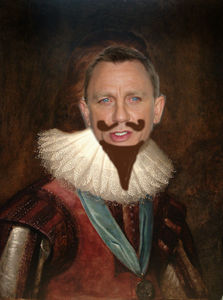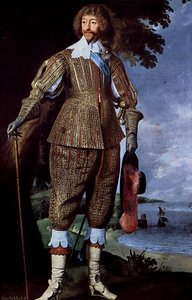There are many ways to get your name on the tube map. You can be a wealthy land owner, run the country, or even pay Transport for London some money. But many of the people immortalised in tube station names have surprising backgrounds or connections. Read on.

Which fictional spy had an ancestor who appears on the tube map?
If you've ever irreverently hummed 007's theme tune while passing through Bond Street station, then you're making more of a connection than you might realise. Bond Street is named after Sir Thomas Bond, whose family motto was Orbis non sufficit, meaning 'the world is not enough'. Ian Fleming's fictional spy also claims this family motto, as established in On Her Majesty's Secret Service, and it is therefore presumed that James Bond is a descendent of the Sir Thomas.
Which station is named after a vicar?
The DLR stop of Langdon Park, which opened in 2007, is the newest namesake station in our list. Like the nearby park and school, the station takes its name from Reverend Charles Godfrey Langdon, vicar of St Michael's, Poplar in the early 20th century. His daughter Mollie was a well-known doctor in the area, at a time when women rarely practiced that profession.
The neighbouring Devons Road station is thought to get its name from Thomas Devon, a local 19th century landowner.

Which three stations are named after men who lost their heads?
Holland Park on the Central Line derives from nearby Holland House, former home of Henry Rich, 1st Earl of Holland. This dashing cavalier was captured by Parliamentary forces and executed outside Westminster Hall in 1649 — his head left his body with one swing of the executioner's axe.
Another dismembrous stop is St John's Wood. The station, and area, is named after former landowners the Knights Hospitaller of the Order of St John. That's the same St John of Baptist fame who memorably had his head served up on a platter. We might also add St Paul's, as some traditions believe that saint was also beheaded by sword, in Rome.
This odd category has further potential additions. Another one to consider is Russell Square whose name comes from the Russell family, but not specifically the treasonous William Russell who was beheaded in Lincoln's Inn Fields. And we could also consider the saint behind St James's, whose fate is unclear but possibly involved decapitation. The network is a grisly place.
Who's the only person to be named on the map three times?
An easy one to guess: it is, of course, Queen Victoria. The former monarch appears prominently as both a station (Victoria) and tube line (Victoria Line), and more covertly in Zone 3 at the Royal Victoria DLR station (itself named after the Royal Victoria Dock). Her consort also appears three stops down at Royal Albert DLR, making them the only couple to appear on the tube map. The superabundant monarch is also referenced in Queensway on the Central Line, Lancaster Gate (namechecking her Royal Duchy), plus Walthamstow Queens Road and Queens Road Peckham Overground stations.

What other royalty have made it onto the map?
The current Queen's grandfather is remembered in another DLR stop: King George V in Zone 3. As a helpful note on Wikipedia enlightens: "Station and on-train announcements refer to the station as 'King George the Fifth'". Nearby, you'll also find Prince Regent DLR, named after the man who would become George IV. More indirectly, King's Cross recalls an unloved monument to George IV in that area, and the Jubilee Line commemorates the silver jubilee of Queen Elizabeth II. Neither monarch is explicitly named though, so we're not counting these ones.
Victoria aside, which other women can be found on the tube map?
While many areas of London are named after wealthy men, quite a few women are also represented.
Warren Street on the Victoria Line is dedicated to Anne Warren, who married local landowner Charles Fitzroy in the mid-18th century. Her daddy was the first to settle Greenwich Village in New York, and that city's Warren Street derives from him.
Gloucester Road can be linked to Maria, Duchess of Gloucester and Edinburgh, who built a house on the street (at the time called Hog Moore Lane) in 1805.
We can't be certain, but the best-guess origins of Arnos Grove are in the family of Margery Arnold, who held land in that area in the 14th century. She's mentioned on documents from the time, and thereafter we see Arnold's Grove becoming Arno's Grove and then Arnos Grove.
Nearby Seven Sisters might also sneak in, depending how strict we're being. It recounts a grove of trees that might (or might not) have had associations with seven real ladies (modern replanting of the trees did involve a septet of siblings). We should also acknowledge Marylebone, whose derivation comes from St Mary. Sadly, the association of Eleanor of Castile with Elephant and Castle has no historical basis, and that name is more probably linked to a pub sign.
Indian rebellion and Indian rubber: which two neighbouring stations?
Canning Town on the Jubilee Line and DLR is often said to be named after Charles John Canning, suppressor of the Indian Rebellion of 1857. The name Canning Town was in use eight years before the rebellion, however, making it possible that his Prime-ministerial father George Canning is the real dedicatee. Yet another theory, quoted in Cyril Harris's book What's in a Name, puts the appellation down to a local firm called Canning. So, who knows? The origins of West Silvertown, the next stop on the DLR, are more certain. Samuel Winkworth Silver opened an India Rubber, Gutta Percha & Telegraph Cable works in the area in 1852. The name Silvertown was in use as soon as 1858.
Where can you find the longest-serving Prime Minister on the map?
Liverpool Street station gets its name from the neighbouring road, which itself is in honour of Lord Liverpool, Prime Minister for the incredible stretch of 1812-1827.
Where can you find a Victorian farmer on the tube map?
Rayners Lane, on the Metropolitan and Piccadilly lines, is said to be named after Daniel Rayner, a local farmer who once owned the land upon which the Met Line was constructed in the first years of the 20th century.
How about a Georgian carpenter?
That'll be John Goodge, who gained land west of Tottenham Court Road through marriage in 1718. His nephews eventually inherited and continued the development of the site into what is now Goodge Street.
And the rest...
Plenty of other individuals are immortalised in station names. Perhaps a quarter of all stops can ultimately be attributed to medieval farmers, chieftans and landowners about whom we know very little. For example, the person called Wemba who gave us Wembley, or the Cena who once owned Kennington. We recently captured these ancient names on a Medieval Tube Map.
Other notables from more recent eras include Robert Sidney, 2nd Earl of Leicester who developed Leicester House and thence Leicester Square; either Edward or William Baker, who held land near Baker Street; late Tudor merchant Edward Latymer, who bequeathed the land that Latimer Road now serves; Denmark Hill Overground is dedicated to Prince George of Denmark, husband of Queen Anne; Tufnell Park gets its name from landowner William Tufnell; and Mornington Crescent is named for the Earl of Mornington, brother of the Duke of Wellington.
There are, no doubt, others we've missed, so shout out below. And who alive today deserves a tube dedication?
Note for pedants: some of these are DLR stations rather than tube stops, but all are on the document that TfL officially calls the 'Tube Map', hence the title of this piece.
Images public domain, except Daniel Craig, by Liam Mendes under Creative Commons licence.




